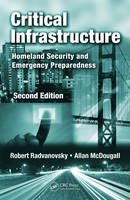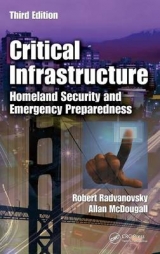
Critical Infrastructure
Crc Press Inc (Verlag)
978-1-4200-9527-2 (ISBN)
- Titel erscheint in neuer Auflage
- Artikel merken
To keep emergency management, disaster response, and homeland security personnel fully current, Radvanovsky and McDougall have updated their essential reference.Keeping pace with the changes in laws and policies made by the Department of Homeland Security, Critical Infrastructure: Homeland Security and Emergency Preparedness, Second Edition reflects the development of the Incident Command System (ICS) and the total revision of the National Response Framework (NRF), implemented in 2008. The book expands sections on the National Institute of Standards and Technology, the Homeland Security Presidential Directives, and Supervisory Control and Data Acquisitions Systems (SCADA) security initiatives.
Includes Downloadable Web References
In addition to being a comprehensive source of highly useful reference material, this timely work also introduces the paradigm shift in thinking that is subtly moving us away from the Force Protection Doctrine toward an All-Hazards approach to CIP. To this end, it re-introduces the term called Critical Infrastructure Assurance (CIA). Keeping pace with this development, the authors demonstrate how emergency management and CIA go hand in hand.
This changing world of ours in which emergency preparedness is finding a permanent niche requires us to integrate and incorporate emergency management and homeland security concepts with infrastructure assurance options. Ultimately, to keep our society both prepare and psychologically healthy we must be able to assure that infrastructure services will continue operating no matter what disaster may befall us.
CIPS, Infracritical, Geneva, Illinois, USA Evolutionary Security Mgmt. Inc., Arnprior, Ontario, Canada
Broken into 11 categories, the book begins with the first priority that must be considered in protecting critical infrastructure and follows with the next 10 in descending order of importance:
Critical Infrastructure Assurance provides the base for the entire book. It explains the importance of CI Assurance to the United States. This section includes new and standard terms and definitions.
Demand, Capacity, and the Emergence of Networks provides theoretical yet important reflection on the emerging trend to think about disruptions less locally and in more networked environments.
The National Response Framework created in March 2008, by the Department of Homeland Security (DHS) is now the standard protocol guide to all-hazards responses—from the smallest incident to the largest catastrophe.
National Incident Management Systems (NIMS) provides proper application of the "chain of command" for any given incident;
Incident Command Systems elaborates about the chain-of-command structure during a crisis, summarizes appropriate courses of action, and defines what makes up a proper and effective Incident Action Plan.
Emergency Preparedness and Readiness deals with the overall concept behind emergency preparedness and summarizes what if scenarios with explanations from the Office of Domestic Preparedness and the U.S. Fire Administration.
Security Vulnerability Assessments provides the backbone for reasons of what, where, why, and how risk assessments are to be performed; and what causes them to be needed. This information is representative of a set of guidelines that our military and government agencies are currently using and/or improving upon.
Standards and Guidelines outlines relevant standards, guidelines, and protocols from various agencies, associations, and councils and how they might apply to critical infrastructure.
Information Sharing and Analysis Centers (ISAC) are the information dissemination points located in particular sectors. This section defines their emergence and role.
Supervisory Control and Data Acquisition discusses the state-of-the-art control systems that should be used within and throughout every sector.
Critical Infrastructure Information outlines and attempts to summarize all classifications of information that would apply to critical infrastructures. Additionally, any legal ramifications, enforcement capabilities, along with the definition of the term "critical infrastructure information" are likewise outlined.
On first glance, there would appear to be significant overlap and this is true, as overlap is essential to the building of a failsafe system. However, there are also significant differences that need to be studied and understood, so that emergency planners and responders can act with confidence and help the populace respond in a measured manner. Ultimate restoration of order and our society’ capacity to prevail rather than just survive is fully dependent on proper preparedness of the highest order.
| Erscheint lt. Verlag | 1.12.2009 |
|---|---|
| Zusatzinfo | N/A; N/A |
| Verlagsort | Bosa Roca |
| Sprache | englisch |
| Maße | 156 x 235 mm |
| Gewicht | 658 g |
| Themenwelt | Sozialwissenschaften ► Politik / Verwaltung ► Europäische / Internationale Politik |
| ISBN-10 | 1-4200-9527-7 / 1420095277 |
| ISBN-13 | 978-1-4200-9527-2 / 9781420095272 |
| Zustand | Neuware |
| Informationen gemäß Produktsicherheitsverordnung (GPSR) | |
| Haben Sie eine Frage zum Produkt? |
aus dem Bereich



